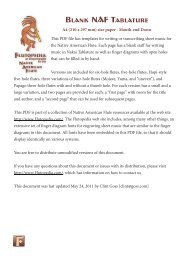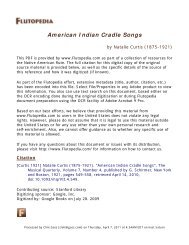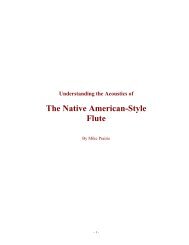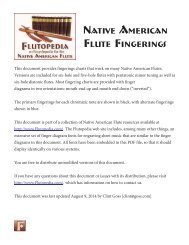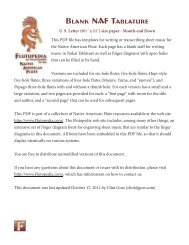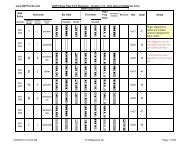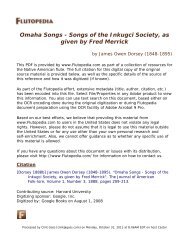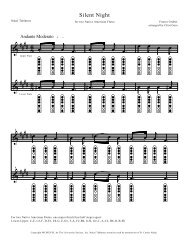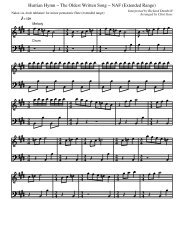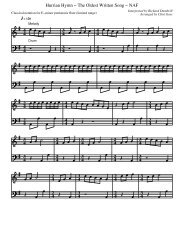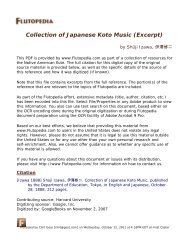Music of Acoma, Isleta, Cochiti, and Zuñi Pueblos - Flutopedia.com
Music of Acoma, Isleta, Cochiti, and Zuñi Pueblos - Flutopedia.com
Music of Acoma, Isleta, Cochiti, and Zuñi Pueblos - Flutopedia.com
Create successful ePaper yourself
Turn your PDF publications into a flip-book with our unique Google optimized e-Paper software.
82 BUREAU OF AMERICAN ETHNOLOGY [Boll. 166<br />
The next day they go out <strong>and</strong> make a great circle around the game.<br />
It is said the animals seem powerless <strong>and</strong> sometimes run toward the<br />
hunters.<br />
Each man keeps the rabbits that he kills<br />
drying the meat or using it in any way he desires.<br />
COCHITI SONGS<br />
<strong>and</strong> discards the hide,<br />
The songs <strong>of</strong> <strong>Cochiti</strong> Pueblo were recorded by Evergreen Tree<br />
(pi. 6, 6), a man from that pueblo (cf. Characterization <strong>of</strong> singers,<br />
p. xii). The records were made in 1930 at Wisconsin Dells, Wis.,<br />
<strong>and</strong> he gave additional information <strong>and</strong> translations in 1931 <strong>and</strong> 1939.<br />
The place <strong>of</strong> recording the songs was picturesque. Evergreen Tree<br />
consented to sing on condition that the songs be recorded under a<br />
little arbor he had made near the house <strong>of</strong> a friend. The arbor was<br />
surrounded by vines, <strong>and</strong> above were the overhanging branches <strong>of</strong><br />
trees. Against one tree he had placed a short ladder, which remotely<br />
suggested the pueblo. In this arbor he spent much <strong>of</strong> his leisure time.<br />
The place was safe from intrusion but not adapted to sound recording<br />
<strong>and</strong> the records were difficult to transcribe. The recording instrument<br />
was a dictaphone with storage battery. It would have been<br />
impossible to use a phonograph under these conditions.<br />
BUFFALO DANCE SONGS<br />
The buffalo hunt <strong>of</strong> the <strong>Cochiti</strong> was held in summer <strong>and</strong> took the<br />
Indians to the plains <strong>of</strong> eastern New Mexico (cf. Benedict, 1931,<br />
pp. 197-200). This was not like an ordinary hunting expedition,<br />
for the people held the buffalo in high esteem, saying "the buffalo<br />
never turns to right or left but always moves forward." The hunt<br />
was preceded by a dance that lasted only 1 day, <strong>and</strong> its purpose was<br />
to honor the buffalo "who gave his flesh for the good <strong>of</strong> the people."<br />
On the evening before the Buffalo dance there was an announcement<br />
<strong>of</strong> the event by the dancers from both kivas. This|was called<br />
by a term literally translated "taking out the rooster." Members <strong>of</strong><br />
each kiva group met in their respective <strong>com</strong>munity houses. According<br />
to this informant, the <strong>Cochiti</strong> clans are Sun, Water, Cottonwood,<br />
Oak, Corn, Fire, Turquoise, Calabash, Bear, Coyote, <strong>and</strong><br />
Mountain lion. He belonged to the Calabash clan which had its<br />
<strong>com</strong>munity house on the west side <strong>of</strong> the plaza. The Turquoise was<br />
one <strong>of</strong> the clans on the east side <strong>of</strong> the plaza. In announcing the<br />
Buffalo dance, one group, with many drunmiers, went around the<br />
plaza singing <strong>and</strong> dancing, then returned to their <strong>com</strong>munity house.<br />
Then the other group did the same, but did not give the same dance.<br />
Remembering the scene. Evergreen Tree said, "it was dusk when<br />
the singers went through the streets <strong>and</strong> they could see the women<br />
At about 9 o'clock<br />
in the houses getting the food ready for the feast.



